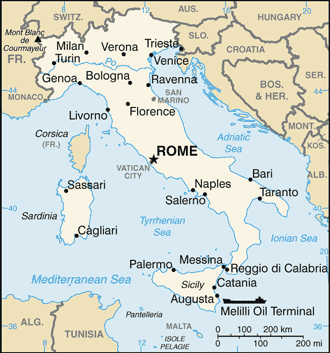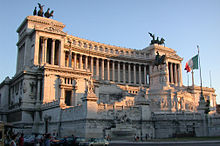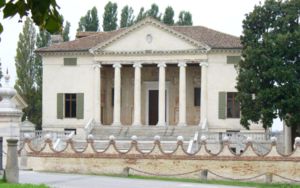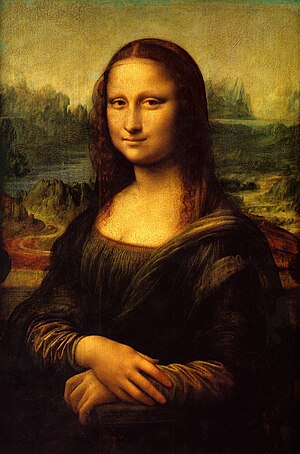Difference between revisions of "Italy"
m |
m |
||
| Line 1: | Line 1: | ||
| − | |||
{| border=1 align=right cellpadding=4 cellspacing=0 width=300 style="margin: 0 0 1em 1em; background: #555555; border: 1px #aaaaaa solid; border-collapse: collapse; font-size: 95%;" | {| border=1 align=right cellpadding=4 cellspacing=0 width=300 style="margin: 0 0 1em 1em; background: #555555; border: 1px #aaaaaa solid; border-collapse: collapse; font-size: 95%;" | ||
|+<big><big>'''Repubblica Italiana'''</big></big> | |+<big><big>'''Repubblica Italiana'''</big></big> | ||
| Line 48: | Line 47: | ||
|colspan="2"| <small><sup>1</sup> [[French language|French]] is co-official in the [[Aosta Valley]]; [[German language|German]] is co-official in [[South Tyrol]].<br> | |colspan="2"| <small><sup>1</sup> [[French language|French]] is co-official in the [[Aosta Valley]]; [[German language|German]] is co-official in [[South Tyrol]].<br> | ||
<sup>2</sup> Prior to 1999: [[Lira|Italian Lira]].</small> | <sup>2</sup> Prior to 1999: [[Lira|Italian Lira]].</small> | ||
| − | |}'''Italy''' ([[Italian language|Italian]]: ''Repubblica Italiana'' or ''Italia'') is a country in southern [[Europe]]. It comprises the ([[boot]]-shaped) Apennine [[peninsula]] and two large islands in the [[Mediterranean Sea]], [[Sicily]] and [[Sardinia]], and shares its northern alpine boundary with [[France]], [[Switzerland]], [[Austria]] and [[Slovenia]]. The independent countries of [[San Marino]] and the [[Vatican City]] are [[enclave]]s within Italian territory. | + | |} |
| + | {{X}} | ||
| + | |||
| + | |||
| + | '''Italy''' ([[Italian language|Italian]]: ''Repubblica Italiana'' or ''Italia'') is a country in southern [[Europe]]. It comprises the ([[boot]]-shaped) Apennine [[peninsula]] and two large islands in the [[Mediterranean Sea]], [[Sicily]] and [[Sardinia]], and shares its northern alpine boundary with [[France]], [[Switzerland]], [[Austria]] and [[Slovenia]]. The independent countries of [[San Marino]] and the [[Vatican City]] are [[enclave]]s within Italian territory. | ||
== History == | == History == | ||
Latest revision as of 21:17, 1 April 2009
| |||||
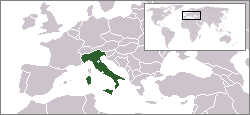
| |||||
| Official language | Italian1 | ||||
| Capital and largest city | Rome | ||||
| President | Carlo Azeglio Ciampi | ||||
| Prime minister | Silvio Berlusconi | ||||
| Area - Total - % water |
Ranked 71st 301,336 km² 2.40% | ||||
| Population - Total (December 2004) - Density |
Ranked 23rd 58,462,375 194/km² | ||||
| Unification | 17 March 1861 | ||||
| GDP (2004) - Total (PPP) - Total (nom.) - GDP/capita (PPP) - GDP/capita (nom.) |
$1.621 trillion (8th) $1.672 trillion (6th) $27,727 (19th) $28,599 (20th) | ||||
| HDI (2003) | 0.934 (18th) – high | ||||
| Currency | Euro (€)2 | ||||
| Time zone - in summer |
CET (UTC+1) CEST (UTC+2) | ||||
| National anthem | Il Canto degli Italiani | ||||
| Internet TLD | .it | ||||
| Calling Code | +39 | ||||
| 1 French is co-official in the Aosta Valley; German is co-official in South Tyrol. 2 Prior to 1999: Italian Lira. | |||||
Italy (Italian: Repubblica Italiana or Italia) is a country in southern Europe. It comprises the (boot-shaped) Apennine peninsula and two large islands in the Mediterranean Sea, Sicily and Sardinia, and shares its northern alpine boundary with France, Switzerland, Austria and Slovenia. The independent countries of San Marino and the Vatican City are enclaves within Italian territory.
History
Main article: History
Italy has shaped the cultural and social development of the whole Mediterranean area, deeply influencing European culture as well. Important cultures and civilizations have existed there since prehistoric times. After Magna Graecia, the Etruscan civilization and especially the Roman Republic and Empire that dominated this part of the world for many centuries, Italy was central to European philosophy, science and art during the Middle Ages and the Renaissance.
Modern Italy became a nation-state belatedly — on March 17, 1861, when most of the states of the peninsula were united under king Victor Emmanuel II of the Savoy dynasty, which ruled over Sardinia and Piedmont. The architects of Italian unification were Count Camillo Benso di Cavour, the Chief Minister of Victor Emmanuel, and Giuseppe Garibaldi, a general and national hero. Rome itself remained for a decade under the Papacy, and became part of the Kingdom of Italy only on September 20, 1870. The Vatican is now an independent enclave surrounded by Rome.
In the early 1920s, Benito Mussolini took control of Italy and Italy became fascist. Mussolini allied with Germany in World War II, which led to the downfall of the fascist government.
Politics
Main article: Politics
The 1948 Constitution of Italy established a bicameral parliament (Parlamento), consisting of a Chamber of Deputies (Camera dei Deputati) and a Senate (Senato della Repubblica), a separate judiciary, and an executive branch composed of a Council of Ministers (Cabinet) (Consiglio dei ministri), headed by the Prime Minister of Italy (Presidente del consiglio dei ministri). The President of the Republic (Presidente della Repubblica) is elected for 7 years by the parliament sitting jointly with a small number of regional delegates. The president nominates the prime minister, who proposes the other ministers (formally named by the president). The Council of Ministers must retain the support (Fiducia) of both houses.
The houses of parliament are popularly and directly elected by a mixed majoritarian and proportional representation system. Under 1993 legislation, Italy has single-member districts for 75% of the seats in parliament; the remaining 25% of seats are allotted on a proportional basis. The Chamber of Deputies has officially 630 members (de facto, 619 only after the 2001 elections). In addition to 315 senators, elected members, the Senate includes former presidents and several other persons (no more than 5) appointed for life by the President of the Republic according to special constitutional provisions. Both houses are elected for a maximum of 5 years, but either may be dissolved before the expiration of its normal term. Legislative bills may originate in either house and must be passed by a majority in both.
The Italian judicial system is based on Roman law modified by the Napoleonic code and later statutes. A constitutional court, the Corte Costituzionale, passes on the constitutionality of laws, and is a post-World War II innovation.
To vote for the senate, the voter must be at least 25. To vote for anything else, the voter must be at least 18.
Regions
Main article: Regions of Italy
Italy is subdivided into 20 regions (regioni, singular regione), of which five enjoy a special autonomous status that enables them to enact legislation on some of their specific local matters, marked by an *:
Geography
Main article: Geography of Italy
Italy consists predominantly of a large peninsula with a distinctive boot shape that extends into the Mediterranean Sea, where together with its two main islands Sicily and Sardinia it creates distinct bodies of water, such as the Adriatic Sea to the north-east, the Ionian Sea to the south-east, the Tyrrhenian Sea to the south-west and finally the Ligurian Sea to the north-west.
The Apennine mountains form the backbone of this peninsula, leading north-west to where they join the Alps, the mountain range that then forms an arc enclosing Italy from the north. Here is also found a large alluvial plain, the Po-Venetian plain, drained by the Po River and its many tributaries flowing down from the Alps, Apennines and Dolomites.
Other well-known rivers include the Tiber, Adige and Arno.
Its highest point is Mont Blanc (Monte Bianco) at 4,810 m, but Italy is more typically associated with two famous volcanoes: the currently dormant Vesuvius near Naples and the very active Etna on Sicily.
Demographics
Main article: Demographics
Italy is largely homogeneous in language and religion but is diverse culturally, economically, and politically. The country has the fifth-highest population density in Europe at 194 persons per square kilometre. Indigenous minority groups are small. For a country of 58.5 million people, Italy has a smaller number of migrants compared to France and Germany. According to ISTAT, the national statistical office, Italy has 2 million (3.5%) foreigners. While according to the last figure (Caritas est. 2005 [1], almost 3 million of immigrants live legally in Italy, making up 5% of the total population. (while figure for undocumented immigrants vary from 0.8 million to 2 million. Italy is periodically legalizing unauthorized foreigners). The largest immigrant groups are Romanian (445,812) (unoficially 1,000,000 ), Albanian (270,383), Moroccan (253,362) and Chinese (86,738). There are many other ethnic groups, like Filipinos, Tunisians, Croatians, Serbians, and Ukrainians, but they make smaller numbers. An October 2005 report estimates that 1,061,400 Romanians are living in Italy, constituting 37.2% of 2.8 million immigrants in that country. [2]
Economy
Main article: Economy
Italy has a diversified industrial economy with roughly the same total and per capita output as France and the United Kingdom. This capitalistic economy remains divided into a developed industrial north, dominated by private companies, and a less developed agricultural south, with 20% unemployment. In comparison to its western European neighbours, it has a high number of small to medium sized enterprises (SMEes).
Most raw materials needed by industry and more than 75% of energy requirements are imported. Over the past decade, Italy has pursued a tight fiscal policy in order to meet the requirements of the Economic and Monetary Union and has benefited from lower interest and inflation rates. Italy joined the Euro from its conception in 1999.
Italy's economic performance has at times lagged behind that of its EU partners, and the current government has enacted numerous short-term reforms aimed at improving competitiveness and long-term growth. It has moved slowly, however, on implementing certain structural reforms favoured by economists, such as lightening the high tax burden and overhauling Italy's rigid labour market and expensive pension system, because of the current economic slowdown and opposition from labour unions.
Although Roman Catholicism is the majority religion (85% of native-born citizens are nominally Catholic) there are mature Protestant and Jewish communities and a growing Muslim (see: Islam in Italy) immigrant community, as many come from Albania, Morocco, and Tunisia.
Culture
Main Article Culture
Italy, as a country, did not exist until the unification of its city states, the Risorgimento, came to a conclusion around the year 1861. Due to this comparatively late unification, and the historical autonomy of the many regions that comprise the Italian peninsula, many traditions and customs that we now recognize as distinctly Italian can be identified by their regions of origin, which further reflect the influence of the many different peoples that occupied those areas, and of the importance of religion, especially Roman Catholicism. Despite the pronounced political and social isolation of these regions that prevailed throughout Italy's history, Italy's contributions to the cultural and historical heritage of Europe remain immense.
Italy has been a seminal place for many artistic and intellectual movements that spread throughout Europe and beyond, including the Renaissance and Baroque. Perhaps Italy's greatest cultural achievements lie in its long artistic heritage, of which is often validated through the names of Michelangelo, da Vinci, Donatello, Botticelli, Fra Angelico, Tintoretto, Caravaggio, Bernini, Titian and Raphael, among many others. Beyond art, Italy's contributions to the realms of literature, science and music cannot be overlooked.
With the basis of the modern Italian language established through the eminent Florentine poet, Dante Alighieri, whose greatest work, the Divina Commedia is often considered the foremost literary statement produced in Europe during the Middle Ages, we find no shortage of celebrated literary figures; Boccaccio, Castiglione and Pirandello, and the poets Tasso, Ariosto, Leopardi, and Petrarch, whose best known vehicle of expression, the sonnet, was invented in Italy. Prominent philosophers include Bruno, Ficino, Machiavelli, Vico, Gentile, and Eco.
In science, we find Galileo Galilei, whose advancements toward the scientific revolution are considerable, and Leonardo da Vinci, the quintessential Renaissance Man. Other notable Italian scientists and inventors include Fermi, Cassini, Volta, Lagrange, Fibonacci, Marconi, and Meucci.
From folk music to classical, music has always played an important role in Italian culture. Having given birth to opera, for example, Italy provides many of the very foundations of the classical music tradition. Some of the instruments that we often associate with classical music, including the piano and violin, were invented in Italy, and many of the existing classical music forms can trace their roots back to innovations of 16th and 17th century Italian music (such as the symphony, concerto, and sonata). Some of Italy's most famous composers include the Renaissance composers Palestrina and Monteverdi, the Baroque composers Corelli and Vivaldi, the Classical composers Paganini and Rossini, and the Romantic composers Verdi and Puccini. Modern Italian composers such as Berio and Nono proved significant in the development of experimental and electronic music.
Football (calcio) is a popular spectator and participation sport. The Italian national team has won the World Cup three times, while major Italian clubs frequently compete at a high level of European competitions.
- Art of Italy
- Cinema of Italy
- Cuisine of Italy
- Food
- Holidays in Italy
- Italian Literature
- List of Italians
- Music of Italy
Languages
Also see Languages of Italy
The official language of Italy is Standard Italian, a direct descendant of Latin. (Some 75% of Italian words are of Latin origin.) However, when Italy was unified, in 1861, Italian existed mainly as a literary language, and was spoken by less than 3% of the population. Different languages were spoken throughout Italian peninsula, many of which were Romance languages which had developed in every region, due to political fragmentation of ItalyTemplate:Rf.
Indeed, each historical region of Italy had its own so-called ‘dialect’ (with ‘dialect’ usually meaning, improperly, a non-Italian Romance language), with variants existing at the township-level.
Massimo d'Azeglio, one of Cavour's ministers, is said to have stated, following Italian unification, that having created Italy, all that remained was to create Italians. Given the high number of languages spoken throughout the peninsula, it was quickly established that 'proper' or 'standard' Italian would be based on the Florentine dialect spoken in most of Tuscany (given that it was the first region to produce authors such as Dante Alighieri, who between 1308 and 1321 wrote the Divina Commedia). A national education system was established - leading to a decrease in variation in the languages spoken throughout the country over time. But was not until the 1960s, when economic growth enabled widespread access to the television programmes of the state television broadcaster, RAI, that Italian truly became broadly-known and quite standardised.
Today, despite regional variations in the form of accents and vowel emphasis, Italian is fully comprehensible to most throughout the country. Nevertheless certain dialects have become cherished beacons of regional variation—the Neapolitan dialect which is extensively used for the singing of popular folk-songs, for instance—and in recent years many people have developed a particular pride in their dialects.
In addition to the various regional variations and dialects of standard Italian, a number of truly separate languages are spoken:
- In the north, the province of South Tyrol (Südtirol in German, Alto Adige in Italian) is almost entirely German-speaking; the area was awarded to Italy following the First World War and her defeat of the Austro-Hungarian Empire. Pockets of German speakers also persist in other north-eastern Italian regions—a remnant of the old Austrian influence on this area of Italy. In total some 300,000 or so Italians speak German as their first language and indeed identify themselves as ethnic Austrians.
- Some 120,000 or so people live in the Aosta Valley region, where a dialect of Franco-Provençal is spoken that is similar to patois dialects spoken in France. About 1,400 people living in two isolated towns in Foggia speak another dialect of Franco-Provençal.
- About 80,000 Slovene-speakers live in the north-eastern region of Friuli-Venezia Giulia near the border with Slovenia.
- In the Dolomite mountains of Trentino-South Tyrol and Veneto there are some 40,000 speakers of the Rhaetian language Ladin.
- A very large community of some 700,000 people in Friuli speak Friulian—another Rhaetian language.
- In the Molise region of central-south Italy some 4,000 people speak Serbo-Croatian. These are the Molise Croats, descendants of a group of people who migrated from the Balkans in the Middle Ages.
- Scattered across southern Italy (Salento and Calabria) are a number of some 30,000 Greek-speakers—considered to be the last surviving traces of the region's Greek heritage. (Ancient Greek colonists reached southern Italy and Sicily about 1500 BC.) They speak a Greek dialect, Griko.
- Some 15,000 Catalan speakers reside around the area of Alghero in the north-west corner of Sardinia—believed to be the result of a migration of a large group of Catalans from Barcelona in ages past.
- The Arbëreshë, of whom there are around 100,000 in southern Italy and in central Sicily—the result of past migrations—are speakers of the Arbëresh dialect of Albanian.
- Finally, the largest group of non-Italian speakers, some 1.6 million people, are those who speak Sardinian, a Romance language which retains many pre-Latin words.
External links
- Presidenza della Repubblica - Official site of the Italian president (in Italian)
- Parlamento - Official site of the Italian parliament (Senate in Italian only)
- Italia.gov.it Main governmental portal (in Italian)
- Ministero degli Affari Esteri, Italian Foreign Office
- Istituto nazionale di statistica
Official sites
- Presidenza della Repubblica - Official site of the President of the Republic of Italy (in Italian)
- Parlamento - Official site of the Italian Parliament (Senate in Italian only)
- The Chamber of Deputies - First Parliament Branch (few languages)
- The Senate of The Italian Republic - Second Parliament Branch (in Italian)
- Italia.gov.it - Main institutional portal (in Italian)
- The Italian Government - The official Website of The President of the Council of Ministries
- Corte Costituzionale - Italian High Court
- Ministero degli Affari Esteri - Italian Foreign Office
- Ministero dell'interno - Ministry of Interior (in Italian)
- Ministero dell'Istruzione, Università e Ricerca - Ministry of Education, University and Research
- Study in Italy - International changes - Ministry of Education
- Ministero della Salute - Ministry of Health
- Ministero della Difesa - Ministry of Defence
- Ministero per gli Italiani nel Mondo - Foreign-Italian Ministry
- Ministero del lavoro - Ministry of Welfare
- Ministero delle Attività Produttive - Ministry of Industry
- Ministero dell'Agricoltura - Ministry of Agriculture
- Ministero di Grazia e Giustizia - Ministry of Justice
- Istituto nazionale di statistica - National Statistics Office (in Italian)
Others
- History of Italy: Primary Documents
- Encyclopaedia Britannica's Italy country page
- Italian Railways
- ENIT - Italian State Tourism Board
- Italian Parks - National and regional parks and protected areas
- List and maps of archaeological sites in Italy
- WWW-VL: History: Italy at IUE
| Regions of Italy | ||||
|---|---|---|---|---|
| Abruzzo • Aosta Valley • Apulia • Basilicata • Calabria • Campania • Emilia-Romagna • Friuli-Venezia Giulia • Lazio • Liguria • Lombardy • Marche • Molise • Piedmont • Sardinia • Sicily • Trentino-South Tyrol • Tuscany • Umbria • Veneto | ||||
